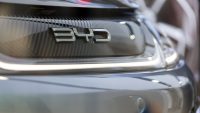I’m not going to start this column by talking about the Ford Fiesta and adding my tiny voice to the cacophony of eulogies we’ve all been subjected to recently.
So, I’m going to talk briefly about another Ford.
A nice man dropped off a Mustang Mach-E to me this week. It’s the GT model so has twin electric motors, four-wheel drive, big red Brembo brake callipers plus the small matter of 480bhp.
And when everything is all primed, ‘Untamed’ mode selected and your spleen braced, this rather large crossover/SUV can cover 0-60mph in the same time as a Porsche 911 Carrera S.
I’ve only driven it a few miles to Waitrose and back as well as to the hall in the next village for rehearsals of a play that I’m appearing in, and happily so far the GT seems to fix quite a few of the complaints I have with the regular Mach-E.
Quite why you need a family car that can accelerate to the national speed limit in 3.7 seconds, however, is beyond me, but that’s a discussion for another day.
It’s the names ‘Mustang’ and ‘GT’ that are interesting here, because let’s face it, there’s nothing remotely Mustang-ish about the Mach-E.
And quite frankly, it’s impossible to make an electric 2.2-tonne SUV feel like a 5.0-litre V8 muscle car, yet Ford still named its first bespoke EV after arguably its most famous car.
When it comes to car names, no-one has a better back catalogue than the Blue Oval.
Thunderbird, Capri, Escort, Sierra, Ka, Falcon, Cortina, Zephyr and Zodiac have been part of many people’s motoring experiences for decades.
And then, of course, there’s Fiesta.
I’m not going to spout the cliched line that ‘everyone has been in a Fiesta at some point in their lives’, but like Mini, Beetle and Defender, it’s a name that really does mean something.
Removing the Fiesta name hurts. Slapping the Fiesta badge on the back of a new small electric car always seemed to be the natural thing that Ford would do, but it’s not going to happen.
Why? Probably because the Fiesta represents the cosy, familiar, dealer-on-every-street-corner shape of Ford, while the electric era offers the chance of reinvention.
If the BBC is known as ‘Auntie’, the Fiesta is your nan.
Ford has a history of wiping the slate clean, of course.
The Sierra ushered in a new, big-shouldered vision in the 1980s, while the razor-edged Focus made the Escort look as exotic as steak and kidney pudding. ‘Mustang’ is having another chance because, well, it’s cool.
Just like every other legacy carmaker, Ford is deep in the throes of the painful shift to mass electrification.
The current period of change is arguably the greatest since the dawn of the motorcar, and with that comes tough decisions.
The death of the Fiesta name is bad enough, but the bigger point is the impending demise of the type of car that it was attached to.
Let’s face it, most people don’t need a car that’s larger than a Fiesta and yet they’re encouraged – and more recently forced – into larger ones.
A growing band of people are being pushed out of small, economical and affordable superminis, and therefore being priced out of the market.
It’s a scandal that the low-cost petrol car is being put to sleep while a like-for-like electric version for the same price is years away.
The fading away of much-loved names will inevitably carry on.
Ford’s electric car alliance partner Volkswagen is, funnily enough, undergoing the same predicament with its ID range of EVs, and it’s only a matter of time before the names ‘Golf’ and ‘Polo’ die forever.
But I think this electric reinvention and deletion of things that are familiar risks losing customers’ allegiances.
Names come and go, but so too can buyers’ loyalties in a world of oh-so-similar EVs.
This column appears in the current edition of Car Dealer – issue 177 – along with news, views, reviews, interviews and much more! You can read and download it for FREE by clicking here!


































